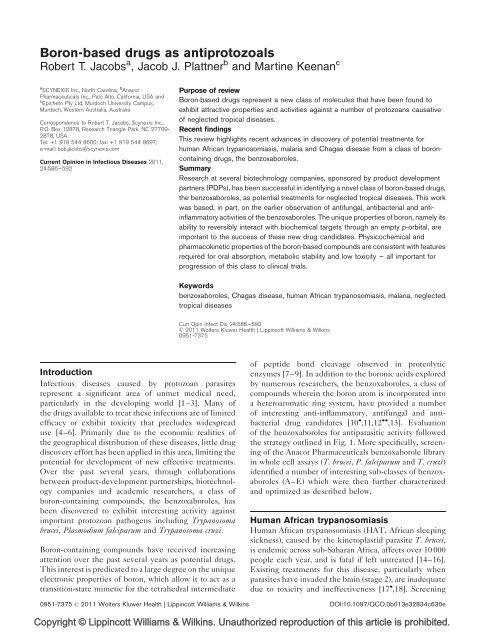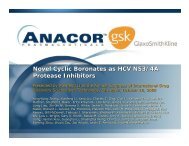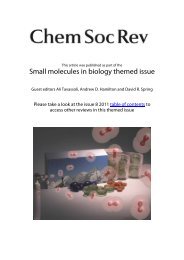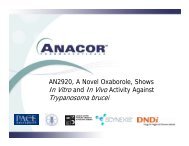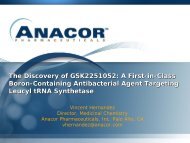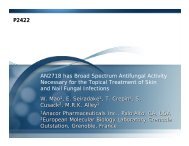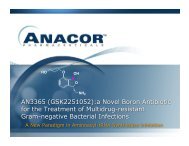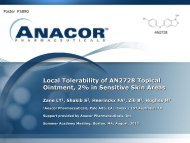Boron-based drugs as antiprotozoals - Anacor
Boron-based drugs as antiprotozoals - Anacor
Boron-based drugs as antiprotozoals - Anacor
You also want an ePaper? Increase the reach of your titles
YUMPU automatically turns print PDFs into web optimized ePapers that Google loves.
588 Antimicrobial agents: viral/par<strong>as</strong>iticFigure 2 Chemical structures of benzoxaborole compounds along with their in-vitro IC 50 results (mmol/l) against TrypanosomabruceiClO=SOHBOOSOHNOHBOOHNOHBO1(0.41 µM)2(0.07 µM)3(0.16 µM)CF 3OHNOHBOFCF 3OHNOHBOFCF 3OHNOHBO4(0.13 µM)5(0.21 µM)6(0.79 µM)Experimental procedures for the in-vitro <strong>as</strong>says are described in [19,20].demonstration of efficacy in the CNS mouse modelfollowing once-daily oral dosing at 12.5 mg/kg [22 ].On the b<strong>as</strong>is of these efforts, SCYX-7158 w<strong>as</strong> progressedto preclinical toxicology and safety pharmacology studies.Results of these studies have supported submission ofa clinical trials application for this compound; ph<strong>as</strong>e 1trials are anticipated in 2012.MalariaThe urgent need for new antimalarial <strong>drugs</strong> [23] coupledwith our success in phenotypic screening of boroncontainingcompounds against bacteria, fungi and trypanosomes,prompted us to initiate a whole cell screeningcampaign against the malaria par<strong>as</strong>ite P. falciparum [24 ].A set of 1034 boron-containing compounds w<strong>as</strong> screenedagainst W2-strain (multidrug resistant) P. falciparum at10 mmol/l, and activities of hits were titrated. IC 50 valueswere below 1 mmol/l for 32 compounds, below 500 nmol/lfor 21 compounds, and below 100 nmol/l for two compounds.Grouping the screened compounds by structuralsimilarity identified five chemical scaffolds that wereanalyzed further for their overall properties. Analysis ofeach of these scaffold families for in-vitro potency,cytotoxicity, uniformity of SAR, and drug-like propertypredictors [25,26] led to selection of two closely relatedseries (D and E) that were selected for lead optimization(Fig. 1).Structures D and E are benzoxaboroles containinga side-chain carboxyl moiety substituted at either the6- or 7-position. SAR studies for lead structures D and Efocused on understanding the importance of the carboxylgroup, the side-chain length, the side-chain atoms andpositional isomers of the carboxyl function around thering. The set of analogs synthesized for this evaluationis shown in Fig. 3 along with their IC 50 values vs.P. falciparum.As seen from the in-vitro data, compound 7, whichcontains a carboxyethyl side chain attached at the7-position of the benzoxaborole nucleus, showed thehighest antimalarial potency with an IC 50 of 26 nmol/l.Lengthening the side chain in 7 or moving it to adjacentring positions reduced antimalarial activity, with the6-position analog 21 showing the second best potency(IC 50 ¼ 120 nmol/l). The excellent potency of 7 w<strong>as</strong>also reduced by alterations to the side-chain terminalfunctional group <strong>as</strong> seen by compounds 13–20, with theacidic tetrazole analog 20 being the best in this setof compounds with an IC 50 of 160 nmol/l. Likewise,replacement of the side-chain benzylic methylene groupin 7 with different heteroatoms also reduced activity(compounds 10–12). Finally, expanding the ring sizeof the oxaborole ring to a 6-membered ring (24) led toinactivity <strong>as</strong> did introduction of gem-di-methyls on theside chain (25) or on the oxaborole ring (26). Pharmacophorealignment analysis of compounds 7, 21 and27 suggests that this series of compounds probablyshare a common binding motif which includes a carboxylatesite, <strong>as</strong> depicted in Fig. 4. Compounds missing thecarboxylate group, such <strong>as</strong> 13 and 18, or compounds withmis-aligned carboxylate group, such <strong>as</strong> compounds22 and 23, all have much weaker activity (>1 mmol/l).In summary, the carboxylic acid containing benzoxaborole7 w<strong>as</strong> found to exhibit excellent in-vitro potency againstP. falciparum. SAR for this series of compounds w<strong>as</strong>Copyright © Lippincott Williams & Wilkins. Unauthorized reproduction of this article is prohibited.
<strong>Boron</strong>-<strong>b<strong>as</strong>ed</strong> <strong>drugs</strong> <strong>as</strong> <strong>antiprotozoals</strong> Jacobs et al. 589Figure 3 Chemical structures of benzoxaborole compounds along with their in-vitro IC 50 results (mmol/l) against Pl<strong>as</strong>modiumfalciparumCOOHCOOHX(CH 2 ) n OH7BOYOHBOOHBO7: n = 2 (0.026 µM)8: n = 3 (0.62 µM)9: n = 4 (2.01 µM)HOOC6510: Y = O (0.46 µM) 13: X = C(O)Me (2.72 µM)11: Y = NH (0.95 µM) 14: X = COOMe (0.32 µM)12: Y = NMe (>5 µM) 15: X = C(O)NH 2 (1.30 µM)16: X = C(O)NMe 2 (>5 µM)17: X = C(O)NHSO 2 -c-Pr (0.46 µM)7 OH18: X = CN (1.02 µM)B19: X = CH 2 NH 2 (0.52 µM)O20: X = CN 4 H (tetrazole) (0.16 µM)421: at 6-position (0.12 µM)22: at 5-position (2.89 µM)23: at 4-position (5 µM) 25 (>5 µM) 26 (>5 µM) 27 (0.16 µM)Experimental procedure for the in-vitro <strong>as</strong>say is described in [24]. Reproduced with permission from [24].Figure 4 Superposition of low energy conformers of compounds7 (cyan), 21 (purple) and 27 (yellow)narrow, and to date, all structural modifications eitherreduced or eliminated activity. Ongoing work, includingpharmacokinetic, efficacy and safety studies will bereported in future publications.Chag<strong>as</strong> dise<strong>as</strong>eThe challenge in the development of new <strong>drugs</strong> to treatChag<strong>as</strong> dise<strong>as</strong>e lies in demonstrating efficacy in thechronic form of the dise<strong>as</strong>e, a difficult condition to modelin preclinical settings and an equally difficult t<strong>as</strong>kto monitor in clinical trials to obtain proof of cure. Thecausative par<strong>as</strong>itic agent T. cruzi invades the muscle cellsof the heart and/or the g<strong>as</strong>trointestinal tract, causingextensive damage to these organs over time [27,28].Other tissues and organs are also affected <strong>as</strong> the dise<strong>as</strong>eprogresses through an acute and then indeterminateph<strong>as</strong>e, presenting <strong>as</strong> a chronic illness some 10–15 yearslater. The current standard of care, benznidazole (28),a nitroimidazole originally thought to mediate par<strong>as</strong>itekilling by inducing oxidative stress [29], but nowproposed to undergo enzyme-mediated activation byCopyright © Lippincott Williams & Wilkins. Unauthorized reproduction of this article is prohibited.
590 Antimicrobial agents: viral/par<strong>as</strong>iticnitroreduct<strong>as</strong>es within the par<strong>as</strong>ite [30–32], is notefficacious in patients with chronic dise<strong>as</strong>e and can causeundesirable side-effects in adults, ranging from g<strong>as</strong>trointestinaldiscomfort to neuropathy, leading to poor patientcompliance over the 60-day treatment regime. Neweragents, posaconazole (29) and ravuconazole (30),shown in Fig. 5, target inhibition of sterol biosynthesisby binding to T. cruzi CYP51, an enzyme required todemethylate the sterol core [33,34]. These agents are thefirst to enter clinical trials for the treatment of Chag<strong>as</strong>dise<strong>as</strong>e in over 40 years. Concern regarding the potentialfor development of resistance to azole-<strong>b<strong>as</strong>ed</strong> therapiessuggests there is a need for new agents acting viadifferent mechanisms in this field.The benzoxaborole scaffold presents an excitingopportunity for the development of a novel therapy forChag<strong>as</strong> dise<strong>as</strong>e. As described above, benzoxaboroles havedemonstrated activity against other protozoan par<strong>as</strong>itessuch <strong>as</strong> P. falciparum and T. brucei, and we have leveragedthe output of the existing HAT drug discovery consortium,screening diversity sets of oxaborole-containingcompounds against T. cruzi to identify a novel Chag<strong>as</strong>lead series. The in-vitro inhibitory activity of ca. 1000compounds screened against T. cruzi in a whole cell <strong>as</strong>sayranged from 0.5 to greater than 10 mmol/l, with clearstructure activity relationship trends noted. The majorityof the compounds of interest (IC 50 1 mmol/l) were<strong>b<strong>as</strong>ed</strong> on the 6-amido oxaborole scaffold successfullyelaborated for the HAT effort. HAT preclinical candidateSCYX-7158 (6) w<strong>as</strong> less active than SCYX-6759 (5),which lacks the gem-dimethyl group on the borolering (IC 50 ¼ 8.42 and 1.15 mmol/l, respectively, Fig. 5).Compound 5 w<strong>as</strong> profiled <strong>as</strong> a benchmark compound ina mouse model of acute T. cruzi infection. Followinga sub-lethal dose of par<strong>as</strong>ites, mice were treated with10 mg/kg orally once daily for 5 days resulting in 100%inhibition of bloodstream par<strong>as</strong>itemia. Given this highlevel of activity at low dose and short treatment period,5 w<strong>as</strong> profiled in a more stringent chronic model whichtests the ability of compounds to clear par<strong>as</strong>ites fromdeep tissue reservoirs. In this model, drug treatment isfollowed by 10 days of monitoring for the return ofpar<strong>as</strong>itemia and monitoring is continued through threerounds of immunosuppression (using cyclophosphamide)and recovery [36]. Mice treated with 5 saw a rebound ofpar<strong>as</strong>itemia prior to the final round of immunosuppression.Higher drug doses and longer treatment times didnot improve this outcome. Although this is a particularlystringent in-vivo model, other agents, for exampleposaconazole, have demonstrated a cure. Subsequentlead optimization work undertaken by the Chag<strong>as</strong> consortiumh<strong>as</strong> identified new analogs with improved in-vitropotency (IC 50 0.2–0.5 mmol/l) and good pharmacokineticprofiles. Typically, these newer, more potent analogssuch <strong>as</strong> 31 have shorter half-lives than 5, yet the in-vivooutcome in the T. cruzi mouse models w<strong>as</strong> the same –100% inhibition of bloodstream par<strong>as</strong>itemia in the acuteFigure 5 Chemical structures of compounds along with their in-vitro IC 50 results (mmol/l) against Trypanosoma cruziONNH28(1.5 µM)OHNNNNO 2ONNNONCOOFNNNNFS HOHCH 330(0.001 µM)FN NNF29(0.03 µM)FCF 3OHNOHBOFCF 3OHNOHBONNF 3 COHNOHBO5(1.15 µM)6(8.42 µM)31(0.49 µM)Experimental procedure for the in-vitro <strong>as</strong>say is described in [35].Copyright © Lippincott Williams & Wilkins. Unauthorized reproduction of this article is prohibited.
<strong>Boron</strong>-<strong>b<strong>as</strong>ed</strong> <strong>drugs</strong> <strong>as</strong> <strong>antiprotozoals</strong> Jacobs et al. 591model and par<strong>as</strong>ite rebound after immunosuppressionin the chronic model. With little known about the biologyof T. cruzi and no specific mode of action identifiedfor oxaborole-containing molecules, the developmentof these agents proceeds empirically. Regardless, 5 andits congeners present an exciting opportunity to finda novel therapy. There are no other boron-<strong>b<strong>as</strong>ed</strong> <strong>drugs</strong>or preclinical molecules reported in the literature <strong>as</strong>having activity against T. cruzi.Conclusion<strong>Boron</strong>-containing compounds such <strong>as</strong> the benzoxaborolesfrom <strong>Anacor</strong> Pharmaceuticals represent an interestingcl<strong>as</strong>s of potential antipar<strong>as</strong>itic drug candidates. Buildingon the known antibacterial, antifungal and antiinflammatoryproperties of this cl<strong>as</strong>s, screening ofbenzoxaboroles in whole cell antipar<strong>as</strong>itic <strong>as</strong>says followedby optimization of physicochemical and pharmacokineticproperties have resulted in identification of severalpotential preclinical candidates. Where<strong>as</strong> not yet fullyexplored for each new drug candidate, the general safetyand toxicological profiles of the benzoxaboroles whichhave progressed to clinical trials for anti-bacterial [37]and anti-inflammatory applications are encouraging[38 ,39,40]. The most advanced antipar<strong>as</strong>itic applicationof the benzoxaboroles is opposite T. brucei, in whicha clinical candidate (SCYX-7158, 6) h<strong>as</strong> been identified.Benzoxaboroles with in-vivo activity against bothP. falciparum and T. cruzi have been identified, andlead compounds for these applications are currentlybeing characterized. In conclusion, the application ofboron-containing compounds <strong>as</strong> treatments for par<strong>as</strong>iticinfections appears to hold promise, but is still at arelatively early stage of development.AcknowledgementsThe authors would like to thank the Drugs for Neglected Dise<strong>as</strong>esinitiative (Robert Don, Eric Chatelain) and Medicines for Malaria Venture(David Waterson) for support of the HAT, malaria and Chag<strong>as</strong> projects.We would also like to recognize the efforts of collaborators atthe University of California, San Francisco (Phil Rosenthal, JimMcKerrow), Pace University (Cy Bacchi, Nigel Yarlett), GSK Tres Cantos(Francisco-Javier Gamo), Swiss Tropical and Public Health Institute(Reto Brun, Marcel Kaiser), Mon<strong>as</strong>h University CDCO (Susan Charman,Karen White) and Murdoch University (Andrew Thompson, AndreaKhong). Finally, the drug discovery and development teams atSCYNEXIS, <strong>Anacor</strong> and Epichem are acknowledged for their hard workand scientific contributions.Conflicts of interestThe following organizations have provided funding for the workdescribed in this review: The Drugs for Neglected Dise<strong>as</strong>es initiativeand Medicines for Malaria Ventures (<strong>Anacor</strong> Oxaboroles, MMV 09/0030).R.T.J. is an employee of SCYNEXIS Inc.; J.J.P. is an employee of <strong>Anacor</strong>Pharmaceuticals Inc.; and M.K. is an employee of Epichem Pty Ltd. Theauthors declare no competing financial interests.References and recommended readingPapers of particular interest, published within the annual period of review, havebeen highlighted <strong>as</strong>: of special interest of outstanding interestAdditional references related to this topic can also be found in the CurrentWorld Literature section in this issue (pp. 615–616).1 Mahmoud A, Zerhouni E. Neglected tropical dise<strong>as</strong>es: moving beyond m<strong>as</strong>sdrug treatment to understanding the science. Health Aff (Millwood) 2009;28:1726–1733.2 Croft SL. Neglected dise<strong>as</strong>es: progress in drug development. Curr OpinInvestig Drugs 2007; 8:103–104.3 Renslo AR, McKerrow JH. Drug discovery and development for neglectedpar<strong>as</strong>itic dise<strong>as</strong>es. Nat Chem Biol 2006; 2:701–710.4 Croft SL, Sundar S, Fairlamb AH. Drug resistance in leishmani<strong>as</strong>is.Clin Microbiol Rev 2006; 19:111–126.5 Robays J, Lefevre P, Lutumba P, et al. Drug toxicity and cost <strong>as</strong> barriers tocommunity participation in HAT control in the Democratic Republic of Congo.Trop Med Int Health 2007; 12:290–298.6 Yun O, Priotto G, Tong J, et al. NECT is next: implementing the new drugcombination therapy for Trypanosoma brucei gambiense sleeping sickness.PLoS Negl Trop Dis 2010; 4:e720.7 Dembitsky VM, Quntar AA, Srebnik M. Recent advances in the medicinalchemistry of alpha-aminoboronic acids, amine-carboxyboranes and theirderivatives. Mini Rev Med Chem 2004; 4:1001–1018.8 Hunter P. Not boring at all. <strong>Boron</strong> is the new carbon in the quest for noveldrug candidates. EMBO Rep 2009; 10:125–128.9 Baker SJ, Tomsho JW, Benkovic SJ. <strong>Boron</strong>-containing inhibitors ofsynthet<strong>as</strong>es. Chem Soc Rev 2011; 40:4279–4285.10 Baker SJ, Zhang YK, Akama T, et al. Discovery of a new boron-containing antifungal agent, 5-fluoro-1,3-dihydro-1-hydroxy-2,1- benzoxaborole (AN2690),for the potential treatment of onychomycosis. J Med Chem 2006; 49:4447–4450.An early report of anti-fungal activity of a benzoxaborole.11 Akama T, Baker SJ, Zhang YK, et al. Discovery and structure-activity study ofa novel benzoxaborole anti-inflammatory agent (AN2728) for the potentialtopical treatment of psori<strong>as</strong>is and atopic dermatitis. Bioorg Med Chem Lett2009; 19:2129–2132.12Seiradake E, Mao W, Hernandez V, et al. Crystal structures of the human andfungal cytosolic Leucyl-tRNA synthet<strong>as</strong>e editing domains: a structural b<strong>as</strong>isfor the rational design of antifungal benzoxaboroles. J Mol Biol 2009;390:196–207.An important publication which describes the characterization of a biochemicaltarget (Leucyl-tRNA synthet<strong>as</strong>e) of the benzoxaboroles, demonstrating thatexpansion of valency at boron is important to reversible interaction with this target.13 Xia Y, Cao K, Zhou Y, et al. Synthesis and SAR of novel benzoxaboroles <strong>as</strong>a new cl<strong>as</strong>s of [beta] -lactam<strong>as</strong>e inhibitors. Bioorg Med Chem Lett 2011;21:2533–2536.14 Brun R, Blum J, Chappuis F, Burri C. Human African trypanosomi<strong>as</strong>is.Lancet 2010; 375:148–159.15 Simarro PP, Jannin J, Cattand P. Eliminating human African trypanosomi<strong>as</strong>is:where do we stand and what comes next? PLoS Med 2008; 5:e55.16 Human African trypanosomi<strong>as</strong>is (sleeping sickness): epidemiological update.Wkly Epidemiol Rec 2006; 81:71–80.17 Croft SL, Barrett MP, Urbina JA. Chemotherapy of trypanosomi<strong>as</strong>es and leishmani<strong>as</strong>is. Trends Par<strong>as</strong>itol 2005; 21:508–512.A good review of the state of current therapy for HAT, Charg<strong>as</strong> and Leishmani<strong>as</strong>iswhich highlights the limitations of current <strong>drugs</strong> and the need for new approachesto these dise<strong>as</strong>es.18 Wilkinson SR, Kelly JM. Trypanocidal <strong>drugs</strong>: mechanisms, resistance and newtargets. Expert Rev Mol Med 2009; 11:e31.19 Ding D, Zhao Y, Meng Q, et al. Discovery of novel benzoxaborole-<strong>b<strong>as</strong>ed</strong> potent antitrypanosomal agents. ACS Med Chem Lett 2010; 1:165–169.Initial description of the trypanocidal activity of benzoxaboroles from high-throughputscreening.20 Nare B, Wring S, Bacchi C, et al. Discovery of novel orally bioavailableoxaborole 6-carboxamides that demonstrate cure in a murine model of latestagecentral nervous system african trypanosomi<strong>as</strong>is. Antimicrob AgentsChemother 2010; 54:4379–4388.21 Jennings FW, Whitelaw DD, Urquhart GM. The relationship betweenduration of infection with Trypanosoma brucei in mice and the efficacy ofchemotherapy. Par<strong>as</strong>itology 1977; 75:143–153.Copyright © Lippincott Williams & Wilkins. Unauthorized reproduction of this article is prohibited.
592 Antimicrobial agents: viral/par<strong>as</strong>itic22Jacobs RT, Nare B, Wring SA, et al. SCYX-7158, an orally-activebenzoxaborole for the treatment of stage 2 human African trypanosomi<strong>as</strong>is.PLoS Negl Trop Dis 2011; 5:e1151.Comprehensive description of the drug discovery program which h<strong>as</strong> delivered thebenzoxaborole SCYX-7158 to clinical evaluation in HAT.23 Enserink M. Malaria’s drug miracle in danger. Science 2010; 328:844–846.24Zhang YK, Plattner JJ, Freund YR, et al. Synthesis and structure-activityrelationships of novel benzoxaboroles <strong>as</strong> a new cl<strong>as</strong>s of antimalarial agents.Bioorg Med Chem Lett 2011; 21:644–651.Initial description of antimalarial activity of benzoxaboroles.25 Lipinski CA. Drug-like properties and the causes of poor solubility and poorpermeability. J Pharmacol Toxicol Methods 2000; 44:235–249.26 Kerns EH, Di L. Multivariate pharmaceutical profiling for drug discovery.Curr Top Med Chem 2002; 2:87–98.27 Prata A. Clinical and epidemiological <strong>as</strong>pects of Chag<strong>as</strong> dise<strong>as</strong>e.Lancet Infect Dis 2001; 1:92–100.28 Bern C. Antitrypanosomal therapy for chronic Chag<strong>as</strong>’ dise<strong>as</strong>e. N Engl J Med2011; 364:2527–2534.29 Apt W. Current and developing therapeutic agents in the treatment of Chag<strong>as</strong>dise<strong>as</strong>e. Drug Des Devel Ther 2010; 4:243–253.30 Wilkinson SR, Bot C, Kelly JM, Hall BS. Trypanocidal activity of nitroaromaticpro<strong>drugs</strong>: current treatments and future perspectives. Curr Top Med Chem2011; 11:2072–2084.31 Hall BS, Wu X, Hu L, Wilkinson SR. Exploiting the drug-activating propertiesof a novel trypanosomal nitroreduct<strong>as</strong>e. Antimicrob Agents Chemother 2010;54:1193–1199.32 Wilkinson SR, Taylor MC, Horn D, et al. A mechanism for cross-resistance tonifurtimox and benznidazole in trypanosomes. Proc Natl Acad Sci U S A 2008;105:5022–5027.33 Lepesheva GI, Hargrove TY, Anderson S, et al. Structural insights intoinhibition of sterol 14alpha-demethyl<strong>as</strong>e in the human pathogen Trypanosomacruzi. J Biol Chem 2010; 285:25582–25590.34 Urbina JA, Payares G, Sanoja C, et al. In vitro and in vivo activities ofravuconazole on Trypanosoma cruzi, the causative agent of Chag<strong>as</strong> dise<strong>as</strong>e.Int J Antimicrob Agents 2003; 21:27–38.35 Buckner FS, Verlinde CL, La Flamme AC, Van Voorhis WC. Efficienttechnique for screening <strong>drugs</strong> for activity against Trypanosoma cruzi usingpar<strong>as</strong>ites expressing beta-galactosid<strong>as</strong>e. Antimicrob Agents Chemother1996; 40:2592–2597.36 Khong A, Kerfoot M, Botero A, et al. A stringent in vivo <strong>as</strong>say for evaluatingthe efficacy of novel compounds against Trypanosoma cruzi in mice.In: Proceedings of the 12th International Conference on Par<strong>as</strong>itology (ICOPAXII); Melbourne, Australia; 2010. www.anacor.com.37 Heyman I, Ip E, Liu L, Maples KR. AN2728 preclinical studies demonstratean acceptable safety profile for the topical treatment of psori<strong>as</strong>is and atopicdermatitis. In: Proceedings of the 67th Annual Meeting of the AmericanAcademy of Dermatology; San Francisco; 2009. www.anacor.com.38 Baker SJ, Ding CZ, Akama T, et al. Therapeutic potential of boron-containing compounds. Future Med Chem 2009; 1:1275–1288.Review of application of boron-containing compounds <strong>as</strong> antifungals, antibacterialsand other applications.39 Zane LT, Shakib S, Milne R, et al. Safety, tolerability and pharmacokinetics ofa novel gram-negative antimicrobial, GSK2251052, in healthy subjects.In: Proceedings of the 21st European Congress of Clinical Microbiologyand Infectious Dise<strong>as</strong>es; Milan, Italu; 2011. www.anacor.com.40 Heyman I, Ip E, Liu L, et al. Preclinical toxicology of AN2728, a novel oxaborolein development for the topical treatment of psori<strong>as</strong>is. In: Proceedings of theInternational Investigative Dermatology Conference; Kyoto, Japan; 2008.www.anacor.com.Copyright © Lippincott Williams & Wilkins. Unauthorized reproduction of this article is prohibited.


